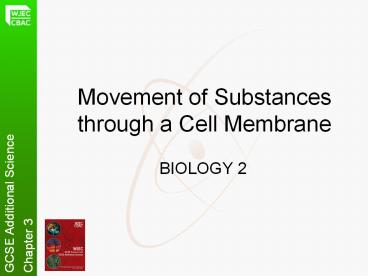Movement of Substances through a Cell Membrane - PowerPoint PPT Presentation
Title:
Movement of Substances through a Cell Membrane
Description:
Movement of Substances through a Cell Membrane GCSE Additional Science Chapter 3 BIOLOGY 2 How do Substances Enter and Leave Cells? Molecules move quickly, at random ... – PowerPoint PPT presentation
Number of Views:73
Avg rating:3.0/5.0
Title: Movement of Substances through a Cell Membrane
1
Movement of Substances through a Cell Membrane
- BIOLOGY 2
GCSE Additional Science
Chapter 3
2
How do Substances Enter and Leave Cells?
- Molecules move quickly, at random, through a
liquid this is called DIFFUSION. Substances
move from a region of high to low concentration.
GCSE Additional Science
Chapter 3
3
- Here the pink molecules will move from the left
to the right until there are the same number of
pink molecules on both sides. The orange
molecules move in the opposite direction. This is
how substances such as oxygen and carbon dioxide
enter and leave cells.
Flow
GCSE Additional Science
Chapter 3
Flow
4
The Following Factors Affect the Rate of
Diffusion
- Concentration the larger the difference between
the concentration of molecules, the faster they
will diffuse. - Temperature the higher the temperature, the
faster diffusion of the molecules. - Pressure the higher the pressure on the
molecules, the faster the movement (from the
region of higher pressure to the region of lower
pressure)
GCSE Additional Science
Chapter 3
5
The Effect of the Cell Membrane on Diffusion
- If a cell membrane was totally permeable (allows
everything in and out), the cell would die in no
time. Even though useful substances would enter
the cell easily, the cells content would diffuse
out. In order to survive therefore, the cell
membrane has to be selectively permeable (allows
only some substances to enter and leave)
GCSE Additional Science
Chapter 3
6
Osmosis
Higher
- Here we can see the water diffusing through a
selectively permeable membrane, from a region of
high concentration to a region of lower water
concentration.
Selectively permeable Membrane
water
GCSE Additional Science
Chapter 3
sugar
High water concentration Low sugar concentration
Low water concentration High sugar concentration
Weak solution
Strong solution
7
Osmosis
Higher
- Here we can see the water diffusing through a
selectively permeable membrane, from a region of
high concentration to a region of lower water
concentration.
Selectively permeable Membrane
water
GCSE Additional Science
Chapter 3
sugar
High water concentration Low sugar concentration
Low water concentration High sugar concentration
Weak solution
Strong solution
8
Osmosis
Higher
- Here we can see the water diffusing through a
selectively permeable membrane, from a region of
high concentration to a region of lower water
concentration.
Selectively permeable Membrane
water
GCSE Additional Science
Chapter 3
sugar
High water concentration Low sugar concentration
Low water concentration High sugar concentration
Weak solution
Strong solution
9
Practical Work
- We can use a special plastic called Visking
tubing to demonstrate osmosis. - Here we can see that the water molecules can
move through the tubing but the sucrose molecules
are prevented. The reason for this is to do with
the size of the molecules. The sucrose molecule
is larger than the water and cannot fit through
the tiny holes in the wall of the tubing. Water
can move into the sucrose solution, but the
sucrose cannot go into the water. - After about half an hour, the solutions level
in the tube will have risen, and the water level
will have dropped.
capillary tube
tight knot
GCSE Additional Science
Chapter 3
sucrose solution
Visking tube
water
10
Practical Work
- Potatoes can be used to demonstrate osmosis in
living tissue. - Potato cylinders of the same length and diameter
are each placed in different concentrations of
sucrose solutions for 20 minutes. - The length and mass of each cylinder should
then be re-measured. The potatoes that have been
in strong sucrose solutions will have reduced in
length and mass, whilst the ones placed in weak
sucrose solutions will have gained length and
mass. - Cylinders showing no change will have cells with
cytoplasm of equal strength to the sucrose
solution that they were placed in.
Distilled Water
0.1M
0.2M
1M
0.5M
Labelled Petri dishes
5mm
GCSE Additional Science
Chapter 3
50mm
Potato cylinder
11
The Importance of Osmosis to Cells
Higher
- If a red blood cell was in a solution containing
less water than itself (hypertonic), then the
cell would lose water. It would shrivel and die.
GCSE Additional Science
Chapter 3
12
Homeostasis
Higher
- It is very important therefore to keep the blood
constant so that the cells in it do not gain or
lose too much water. - The term for keeping these internal conditions
constant is Homeostasis.
GCSE Additional Science
Chapter 3
13
The importance of Osmosis to Cells
Higher
- If a red blood cell was in a solution that had
more water in it than was in the cell
(hypotonic), then it would gain water. It would
expand, burst and die.
GCSE Additional Science
Chapter 3
14
Active Transport
Higher
- In many cases substances are moved into or out
of cells against a diffusion gradient i.e.
opposite to the movement of the molecules. - Energy is needed for this process, and so its
called active transport.
GCSE Additional Science
Chapter 3
15
Examples of Active Transport
Higher
- In the body we see active transport in the small
intestine, when digested food is absorbed into
the blood in the opposite direction to diffusion.
- In a plant, rare minerals from the soil are
pulled into the roots opposite to the direction
of diffusion.
GCSE Additional Science
Chapter 3
16
Summary
- Diffusion is the movement of particles down a
concentration gradient. - Osmosis is the diffusion of water molecules
through a selectively permeable membrane. - Active transport is the movement of molecules
against a concentration gradient this requires
energy.
GCSE Additional Science
Chapter 3































